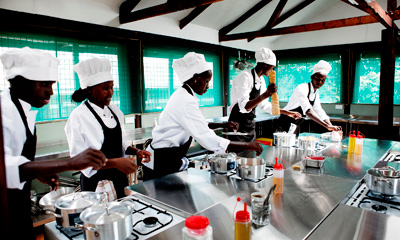Each week we follow the progress of the first intake of students at the Karen Blixen Hospitality School in Kenya. This is a community project run by the Karen Blixen Camp in the Masai Mara to provide training and job opportunities for young Masai in an area with little employment. Real Africa is proud to be supporting this project and we are following the students with interest.
 Rune Eriksen reflects in his personal journey
Rune Eriksen reflects in his personal journey
This week Rune Eriksen the Danish Head Chef and Head Teacher at the Hospitality School looks back at how far both the students and himself have come over the past 11 weeks. Rune arrived in Kenya two weeks before the students started in order to set up the school and the course and he remembers how he arrived from Denmark with no previous experience of Kenya. Over the past few months he says he has learned so much himself and has fallen in love with Kenya and its people but at the same time he still misses his homeland and all the comforts he had there.
When he was in Denmark he felt that he was poorly paid and that food was expensive and not the best quality and that even though he had fresh food available at markets and shops all around him he didn’t appreciate it. Now he lives in Kenya where food is much scarcer and harder to get hold of he realizes just how spoilt for choice he was in Denmark and how privileged he really was. Suddenly he found himself realizing how good life is in Denmark: “They may complain about the weather but the rain in Denmark is nothing compared to the rains here in Kenya during the rainy season. When these heavy rainfalls come you have to cancel your plans as travel becomes almost impossible. The weather is so powerful and nature so fundamental that it reminds you how small and un-important we are in the grand scheme of things. Even whilst out on a rare safari the animals ignore you and you are merely part of a vast landscape. This has made me understand why people spend their lifetime trying to protect and preserve these special places.”
 Introduction to chicken and poultry in the kitchen
Introduction to chicken and poultry in the kitchen
Back in the kitchen the students have also shown great improvement over the weeks with everything from their cooking to their organization when preparing and cooking bush dinners. This week however was all about poultry. The students covered all the different types of poultry from a spring chicken to the old hens for soups and stocks. They use whole chickens in the kitchen whenever possible so the students can practice cutting up and boning chicken as much as possible. If they can master a chicken then they can cut up any other kind of poultry or game birds as well.
To boost their enthusiasm for learning how to cut up the birds and to boost their speed, Rune held a competition, where the students could challenge him. It was wonderful to see how the students could do it at double speed under these conditions but Head Chef Rune remains undefeated!
Chicken Confit
When the week started, Rune asked if the students had any experience with chicken at home. Some had already cooked or eaten chicken where it had been boiled or grilled. This would mean the chicken would be very dry so Rune decided that this would be the week where the students could see just how moist and juicy a chicken could actually be. As Rune is fond of the food that farmers and workers used to eat hundreds of years ago he decided to concentrate on one particular dish, confit chicken. This is a dish that has been around for hundreds of years but is very hard to beat! Simple but extremely tasty. The rest of the day’s food production was to bake a basic bread and to make chicken legs confit. A confit is really an old way to conserve meat. By cooking the meat in fat and then keeping it in the fat until solid it creates a kind of seal removing all the air around the meat. This prevents it from getting old and going off. The farmers’ wives could then cook the meat on a large-scale when one animal was slaughtered and preserve it to feed the family for several weeks. In the days before refrigeration when salt was expensive this was one of the few ways of preserving meat and was very popular. The farmer’s traditional midday meal would then be homemade bread and confit. The students were very interested in the history behind the meal and its basic simplicity and common sense. They also enjoyed eating it! By the end of the week, the students had become very competent cooking chicken in various different ways and in various different dishes. It didn’t matter if it was soup, salad, confit, roasted or poached, the students all did a great job cooking it and understanding the possibilities of this very flexible and adaptable ingredient.
Posted by Ruth Bolton
1 comment
Really inspired by your project at karen blixen camp hospitality school. I am interested in joining your hospitality school but not ailing from maasai mara community. your social responsibility is appreciated and welcomed by other communities too. congratulations.